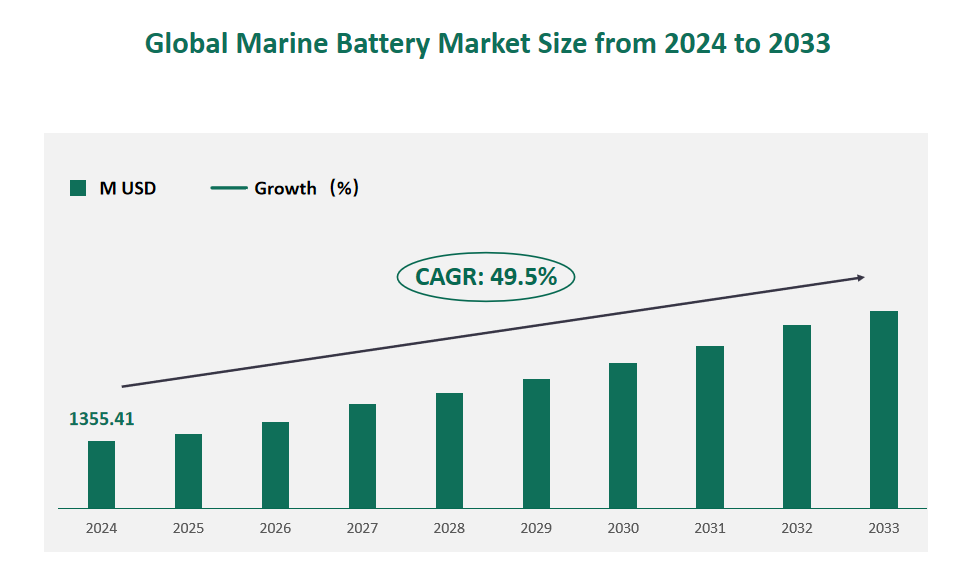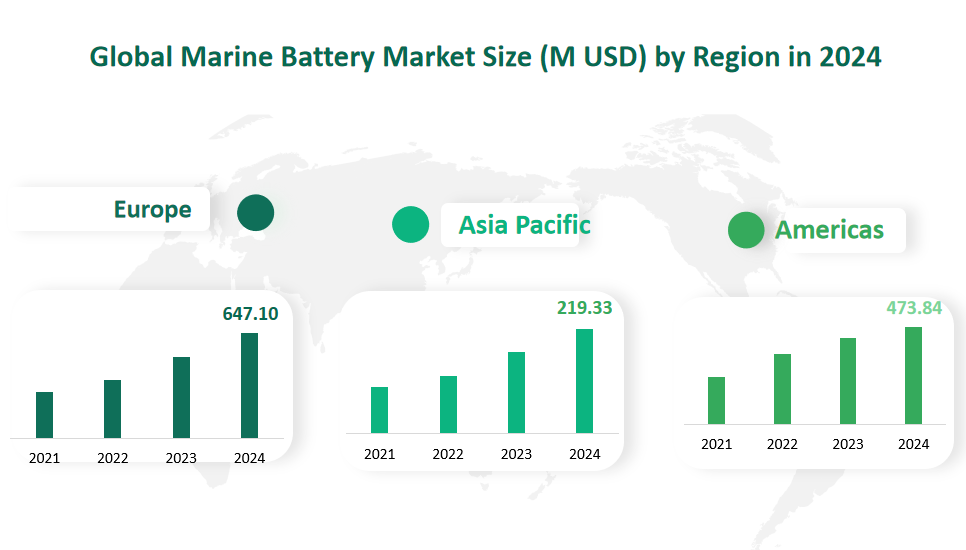1 Global Marine Battery Market Size (Value) and CAGR (2024-2033)
In 2024, the global Marine Battery market was valued at USD 1355.41 million, with a CAGR of 49.5% from 2024 to 2033.
Marine Battery refers to batteries specially designed for use in electric cruise ships, electric official ships, electric cargo ships and other ships. This research report divides products into Lithium-Ion, Nickel Cadmium, Sodium Type, Lead-Acid Battery according to different types of batteries. Electric ships have the advantages of low energy consumption, zero pollution, and low cost. Marine Battery has been widely used in defense, commercial fields.
Figure Global Marine Battery Market Size (M USD) and CAGR 2024-2033

2 Marine Battery Market Drivers
Environmental Concerns and Regulatory Pressures
One of the primary drivers of the marine battery market is the increasing global focus on reducing carbon emissions and combating climate change. The maritime industry, which traditionally relies heavily on fossil fuels, is a significant contributor to greenhouse gas emissions. In response, governments around the world are implementing stricter regulations to limit emissions from ships. For example, the International Maritime Organization (IMO) has set a goal to reduce carbon emissions from shipping by 50% by 2050. This regulatory push is encouraging shipbuilders and operators to adopt cleaner technologies, such as electric propulsion systems powered by marine batteries.
Technological Advancements
Advancements in battery technology are another key driver of the marine battery market. Lithium-ion batteries, in particular, have seen significant improvements in energy density, lifespan, and safety. These advancements make marine batteries more efficient and reliable, capable of meeting the demanding requirements of commercial and defense vessels. For example, modern marine batteries can provide sufficient power for extended periods, enabling ships to operate without frequent recharging.
3 Marine Battery Market Restraints
Technical Barriers
One of the primary challenges in the marine battery market is the high technical barrier to entry. The production of marine batteries, particularly lithium-ion batteries, requires advanced manufacturing capabilities and significant investment in research and development. The materials used in marine batteries, such as the positive and negative electrodes and separators, are capital-intensive and technology-intensive. Major battery manufacturers often have unique technical routes and years of experience in the industry, making it difficult for new entrants to compete.
Customer Resource Barriers
Another significant challenge is the customer resource barrier. Downstream manufacturers, particularly in the defense and commercial maritime sectors, have high standards for supplier selection. They require comprehensive evaluations and certifications of marine battery suppliers, covering aspects such as R&D design capabilities, production equipment, technological processes, management capabilities, product quality, and overall quality control systems. The certification process can be lengthy, often taking 6-24 months, from sample testing and on-site inspections to small-scale procurement and bulk supply.
Once a supplier is certified, downstream customers are reluctant to change suppliers due to the high costs and risks associated with re-certification. This creates a stable market channel for established marine battery manufacturers, making it difficult for new entrants to acquire target customers quickly.
4 Global Marine Battery Market Consumption and Share by Type in 2024
Lithium-ion batteries are the most dominant type in the marine battery market, accounting for the majority of the market share. In 2024, the consumption of lithium-ion batteries is projected to be 5482.8 MWh. These batteries are highly regarded for their high energy density, long cycle life, and relatively low self-discharge rate. They are particularly suitable for applications requiring high power and energy storage, such as electric ferries, cruise ships, and offshore vessels.
Nickel cadmium (NiCd) batteries are another type of marine battery, with a projected consumption of 252.5 MWh in 2024. NiCd batteries are alkaline batteries where the positive active material is primarily nickel and the negative active material is cadmium. They are known for their robustness and ability to withstand deep discharges, making them suitable for applications where reliability and durability are crucial.
Sodium type batteries, including sodium-sulfur batteries, are emerging as a viable option in the marine battery market. In 2024, the consumption of sodium type batteries is expected to be 55.7 MWh. These batteries use molten metal sodium as the negative active material and liquid sulfur and sodium polysulfide molten salt as the positive active material.
Lead-acid batteries are one of the oldest types of rechargeable batteries and continue to play a role in the marine battery market. In 2024, the consumption of lead-acid batteries is projected to be 766.6 MWh. These batteries consist of lead dioxide as the positive electrode, spongy lead as the negative electrode, and sulfuric acid as the electrolyte.
Table Global Marine Battery Market Consumption and Share by Type in 2024
Type | Market Consumption (MWh) 2024 | Market Share 2024 |
Lithium-Ion | 5482.8 | 83.61% |
Nickel Cadmium | 252.5 | 3.85% |
Sodium Type | 55.7 | 0.85% |
Lead-Acid Battery | 766.6 | 11.69% |
5 Global Marine Battery Market Consumption and Share by Application in 2024
In 2024, the consumption of marine batteries for defence applications is projected to be 1678.1 MWh. Defence applications include patrol boats, interceptors, workboats, and other military vessels. These applications require high reliability, durability, and often high power output to support various operational needs, such as propulsion, communication, and weapon systems.
The commercial application segment is expected to consume 4879.5 MWh of marine batteries in 2024. This segment includes electric cruise ships, cargo ships, ferries, and other commercial vessels. The commercial maritime industry is increasingly adopting electric propulsion systems to reduce operational costs, meet environmental regulations, and enhance sustainability.
Electric ferries, in particular, are becoming more common in regions with significant maritime traffic, such as Europe and Asia-Pacific. The growth of the commercial segment is also supported by advancements in battery technology, which have improved the energy density and lifespan of marine batteries, making them more viable for long-haul operations. Additionally, the development of shore power facilities and fast-charging infrastructure is facilitating the adoption of electric ships in commercial applications.
Table Global Marine Battery Market Consumption and Share by Application in 2024
Application | Market Consumption 2024 | Market Share 2024 |
Defence | 1678.1 | 25.59% |
Commercial | 4879.5 | 74.41% |
6 Global Marine Battery Market Size by Region in 2024
The Americas region, comprising the United States, Canada, and Mexico, is expected to have a market value of 473.84 M USD in 2024. The United States is a significant market driver in this region, with substantial investments in both defence and commercial maritime applications. The U.S. Navy’s focus on modernizing its fleet with electric propulsion systems and the increasing adoption of electric ferries in coastal regions are key factors driving the market.
Europe is projected to have a market value of 647.10 M USD in 2024. This region is a leader in the marine battery market, driven by stringent environmental regulations and a strong focus on sustainable shipping. Countries like Norway, the United Kingdom, and Germany are at the forefront of adopting electric propulsion systems for both commercial and defence applications.
The Asia-Pacific region is expected to have a market value of 219.33 M USD in 2024. This region is experiencing rapid growth in the marine battery market, driven by increasing maritime trade and the need for sustainable shipping solutions. China, Japan, and South Korea are key players in this region, with significant investments in electric ship technologies.
Figure Global Marine Battery Market Size by Region in 2024

7 Major Players in Global Marine Battery Market
7.1 The Corvus Energy
Company Profile:
The Corvus Energy is a leading global provider of safe, innovative, and reliable zero-emission solutions for the maritime industry. Established in 2009, the company is headquartered in Norway with manufacturing facilities in both Norway and Canada. The Corvus Energy specializes in large-scale energy storage systems (ESS) using advanced lithium-ion battery technology. Their products are designed to meet the demanding requirements of maritime applications, including ferries, cruise ships, offshore supply vessels, and tugboats.
Business Overview:
The Corvus Energy is renowned for its commitment to sustainability and innovation. The company’s Orca Energy ESS has set a new industry standard for maritime batteries, offering outstanding safety, reliability, and performance. The Corvus Energy has won several environmental awards and holds certifications from major classification societies such as DNV, Lloyd’s Register, ABS, and BV. Their systems are also used in a variety of applications beyond maritime, including hybrid harbor cranes, electric light rail vehicles, and commercial vehicles.
Type Introduction and Recent Financial Performance:
The Corvus Orca Energy ESS is a modular and scalable energy storage system designed for maritime use. It is ideal for applications requiring both high energy and power, such as ferries, cruise ships, and offshore vessels. The Orca Energy system is known for its high performance, low lifetime cost per kWh, and exceptional safety features. In 2022, The Corvus Energy reported a production of 678.4 MWh, a value of 166.60 M USD, and a gross margin of 23.66%.
7.2 EST-Floattech
Company Profile:
EST-Floattech is a Dutch energy technology company specializing in energy storage solutions for offshore and onshore applications. Established in 2004, the company is headquartered in the Netherlands with production facilities in Bad Hovedorp. EST-Floattech has a strong track record of over 200 projects and is recognized as one of the world’s leading suppliers of offshore battery power.
Business Overview:
EST-Floattech offers a comprehensive range of energy systems, including navigation and communication equipment, computer networking, data link, and multimedia products. Their Green Orca modules are designed to meet various maritime needs, such as hotel load, peak shaving, and diesel-electric engine power. The company’s innovative active battery management systems ensure optimal performance and safety in demanding maritime environments.
Type Introduction and Recent Financial Performance:
The Green Orca 1050 is a versatile energy storage module designed for maritime applications. It is suitable for a wide range of functions, including heating superyacht swimming pools and stabilizing azimuth thrusters. The Green Orca 1050 is known for its reliability, flexibility, and ability to deliver high power output. In 2022, EST-Floattech reported a production of 298.4 MWh, a value of 58.94 M USD, and a gross margin of 34.94%.
7.3 Siemens
Company Profile:
Siemens is a global leader in energy technology, with a history dating back to 1847. The company is headquartered in Germany and operates worldwide. Siemens Energy AG focuses on providing energy systems for the future, supporting the transition to a more sustainable world. Their portfolio includes conventional and renewable energy technologies, such as gas and steam turbines, hybrid power plants, and energy storage solutions.
Business Overview:
Siemens offers a wide range of products and services for the maritime industry, including energy storage systems designed to optimize power generation and reduce emissions. The BlueVault™ energy storage solution is a key product, designed to provide reliable and efficient energy storage for maritime applications. Siemens’ commitment to innovation and sustainability has positioned them as a major player in the marine battery market.
Type Introduction and Recent Financial Performance:
The BlueVault™ energy storage solution is an advanced lithium-ion battery-based system designed for all-electric and hybrid maritime applications. It is suitable for new builds and retrofit projects, providing continuous power and minimizing emissions. The BlueVault™ system is known for its high performance, safety, and flexibility, making it an ideal choice for various maritime vessels. In 2022, Siemens reported a production of 209.6 MWh, a value of 43.83 M USD, and a gross margin of 30.88%.

